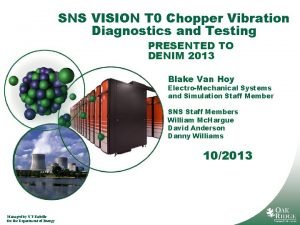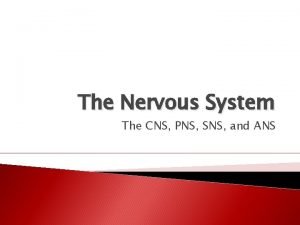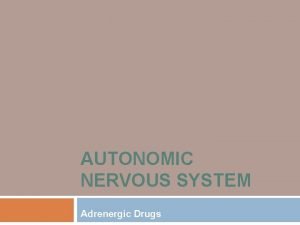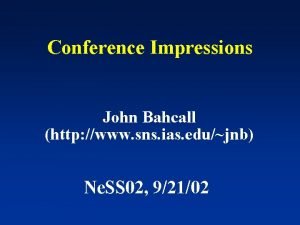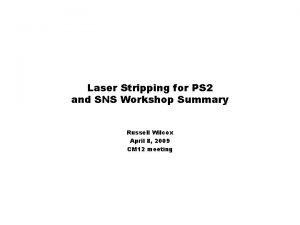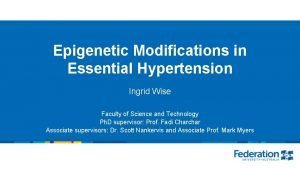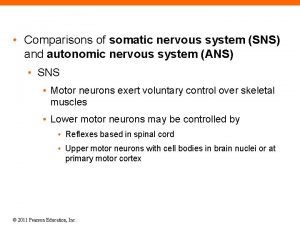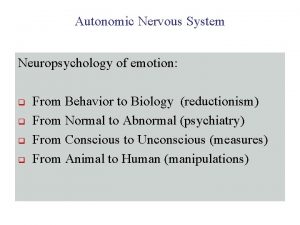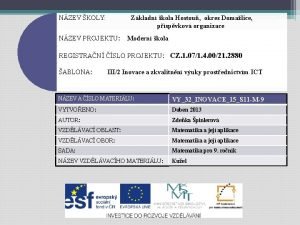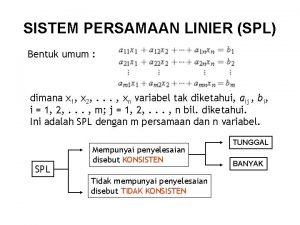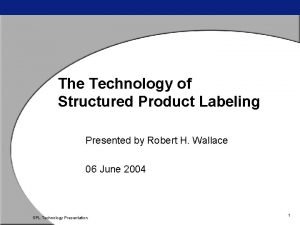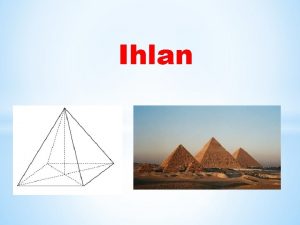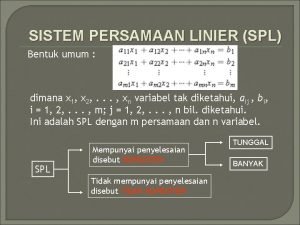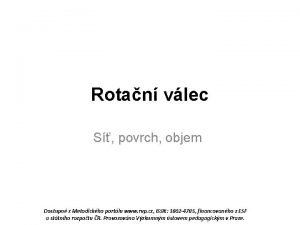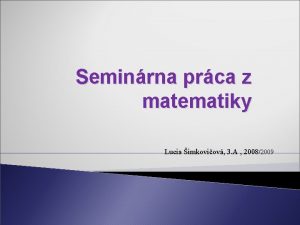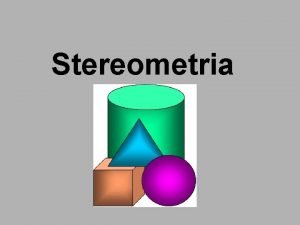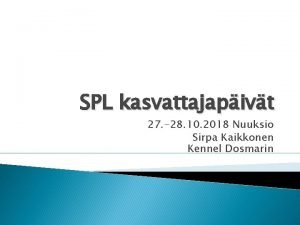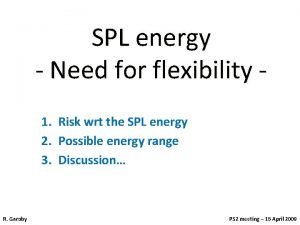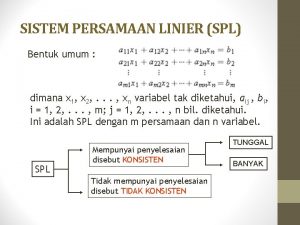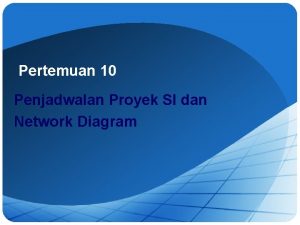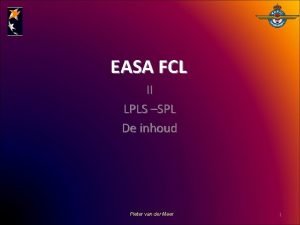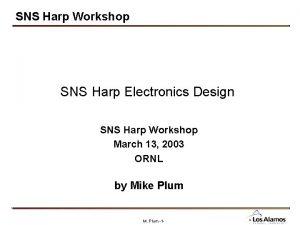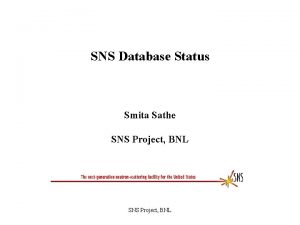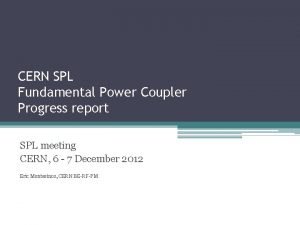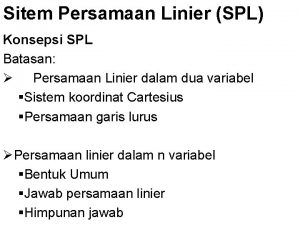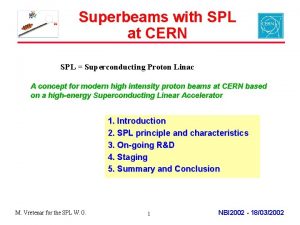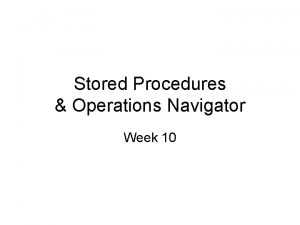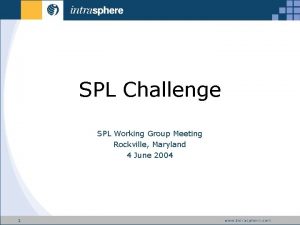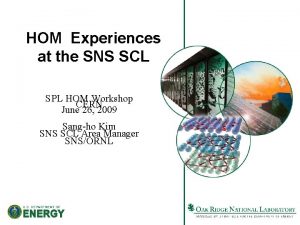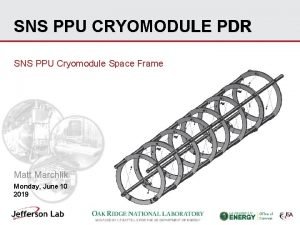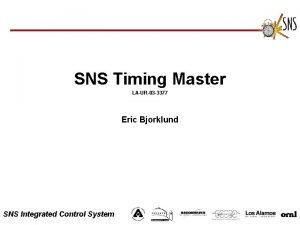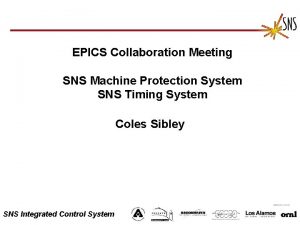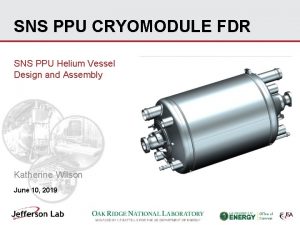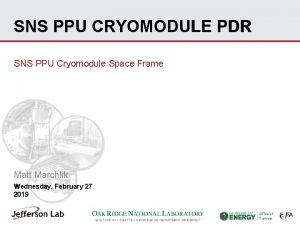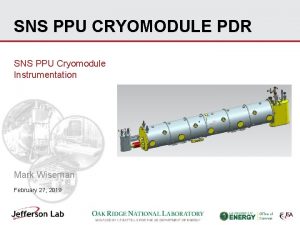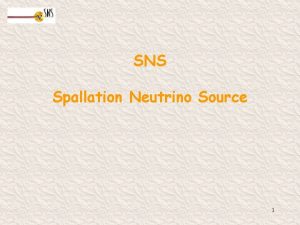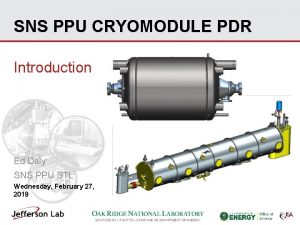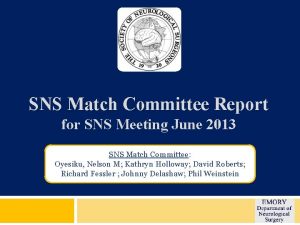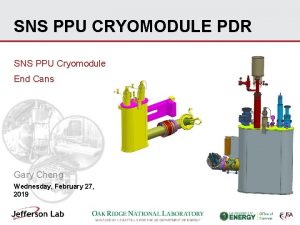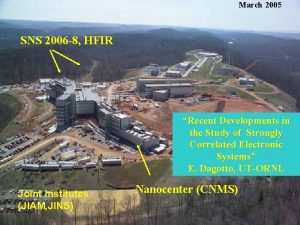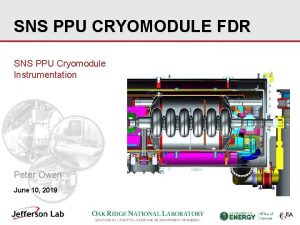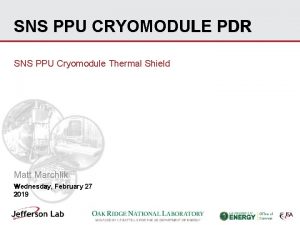The Status of the SNS 3 rd SPL









































- Slides: 41

The Status of the SNS 3 rd SPL Collaboration Meeting CERN Nov. 11 -13, 2009 Sang-ho Kim SCL Area Manager SNS/ORNL

Outlines • SNS operational status • Technical Issues and status – – – RFQ Foil HVCM Beam loss & Activation SCL • Power Upgrade; Impact on SCL • Summary 2 Managed by UT-Battelle for the U. S. Department of Energy

SNS Accelerator Complex Front-End: Produce a 1 -msec long, chopped, Hbeam 2. 5 Me. V Accumulator Ring Collimators 1 Ge. V LINAC Accumulator Ring: Compress 1 msec long pulse to 700 nsec Injection Extraction RF 87 Me. V 186 Me. V 387 Me. V 1000 Me. V Liquid Hg RTBT Target 1300 Me. V Ion Source RFQ DTL CCL SRF, b=0. 61 SRF, b=0. 81 PUP Target 1 ms macropulse 3 Managed by UT-Battelle for the U. S. Department of Energy Current mini-pulse Current 945 ns Chopper system makes gaps 1 ms

Major Parameters achieved vs. designed Design Individually achieved Highest production beam Beam Energy (Ge. V) 1. 01 0. 93 Peak Beam current (m. A) 38 40 36 Average Beam Current (m. A) 26 26 24 1000 825 60 60 60 Beam Power on Target (k. W) 1440 1030 Linac Beam Duty Factor (%) 6. 0 5. 0 1. 5 x 1014 1. 55 x 1014 1. 1 x 1014 81 80 80 Parameters Beam Pulse Length (ms) Repetition Rate (Hz) Beam intensity on Target (protons per pulse) SCL Cavities in Service 4 Managed by UT-Battelle for the U. S. Department of Energy

SNS Beam Power Performance History 1 MW beam power on target achieved in routine operation HVCM Ion Source, LEBT 5 Managed by UT-Battelle for the U. S. Department of Energy Target CMS leak Stripper foil

Smooth Running… 6 Managed by UT-Battelle for the U. S. Department of Energy

Sometimes not… 7 Managed by UT-Battelle for the U. S. Department of Energy

Power delivery goals for FY 09 8 Managed by UT-Battelle for the U. S. Department of Energy

FY 09 Neutron Production hours goals 9 Managed by UT-Battelle for the U. S. Department of Energy

High Intensity Beam Studies – 7/11/2009 1 Hz beam Beam Pulse Extracted from the Ring: • Full baseline design intensity stored and extracted • No gross instability observed Current (m. A) Linac Beam waveform: • ~ 1 msec long • produces the design intensity Time relative to Ring Extraction (turns) 10 • The linac delivered the full pulse length • For the first time we verified the Ring can stably store and extract the design intensity Managed by UT-Battelle for the U. S. Department of Energy 14

Technical Issues and Status 11 Managed by UT-Battelle for the U. S. Department of Energy

RFQ instability • It was difficult to get stable operation at 60 Hz, >700 us – >30 min. down time in a day – Resonance error goes down loosing closed loop Vane water temperature Resonance error 20 k. Hz Resonance error Loosing closed-loop 10 min. • One of limitations for 1 MW; 12 − Since March 09; an extensive investigation − Why? What causes this instability? Limiting condition? Managed by UT-Battelle for the U. S. Department of Energy

All stable except net RF power resonance error fluctuation • Resonance error; pure passive parameter • Net RF power=forward power – reflected power +/-2 k. Hz Resonance error Net RF power +/-10 k. W Water temperature 13 Managed by UT-Battelle for the U. S. Department of Energy

RFQ Instability; findings • Direct correlation between Net RF power and res. Error – When Net power > +40 k. W RFQ becomes unstable • Changes in resonance error – Vanes are getting hotter/colder at a constant field, water temperature • Load changes are clearly observed when – Hydrogen flow rate is changed; slow response – (Source off) vs. (source on/beam off); fast response – (Source on/beam off) vs. (source on/beam on); fast response • Theory 14 – RFQ (especially vane) absorbs hydrogen from ion source – Hydrogen are desorbed by ion beam bombardments – Local vacuum goes up (gauge reading at the wall may not see any changes) – Local discharge (very mild) starts; discharge conditions changes – Vane temperature changes resonance error changes – When discharge reaches a runaway condition instability Managed by UT-Battelle for the U. S. Department of Energy

RFQ operation improvements • Minimize H 2 flow rate in Ion Source (minimize H 2 absorption) • Better source alignment (minimum, uniform desorption) • Operate chiller in a good regulation region • Run the gradient at a lower end – No affection in transmission, beam loss, beam quality • Run at positive resonance error (around 12 k. Hz ± 5 k. Hz) – Colder vane 15 • New auto tuning mechanism (LLRF) trip due instability at 60 – Fine. No tuning; pulseto width adjustment (+/-Hz, 30 900 us) us (limited bychiller HVCM pulse width) – Coarse tuning; temperature at 0. 1 during C step this operation period started on 8/29/09 Managed by UT-Battelle for the U. S. Department of Energy

Foil issues • May 09 ~ June 09; foil failures at >700 k. W run • June 09~July 09; ~ 400 k. W • Causes? – Best foil failure theory to date is that one of the primary causes is vacuum breakdown (arcing) caused by charge build up on the stripper foils, caused by SEM and maybe thermionic electron emission – Another primary cause is reflected convoy electrons and possibly also electrons from trailing edge multipacting – Some of our foil failures also involved convoy electrons hitting the foil bracket 16 Managed by UT-Battelle for the U. S. Department of Energy Cathode spot?

Foil failures (Failed May 3) (Failed June 12) (Failed June 15) (Failed May 3) tear 17 Managed by UT-Battelle for the U. S. Department of Energy (Used for high intensity run July 11 -13)

Foil Fluttering & Glowing Edge/Spot 18 Managed by UT-Battelle for the U. S. Department of Energy

Foil Status • Our best guess to date is that we have multiple foil failure mechanisms, and the biggest ones are vacuum breakdown, reflected convoy electrons, and trailing edge multipacting • The Sep – Dec run has new Ti brackets, new foil mounting method, and diamond foils with a longer free length • Also an HBC foil, and a diamond foil mounted at an angle • The new instrumentation (foil camera, temperature measurement, clearing electrode, faster vacuum update rates) should help us to understand what is going on • No foil failure since September and till now in 19 Managed by UT-Battelle for the U. S. Department of Energy

HVCM Improvement • New capacitors • New IGBTs, physical configuration changes, etc • Running at about 82 % of design duty • This run (since September 1, 09~) – Much less down time due to smoke alarm related – Still major down time in SNS 20 Managed by UT-Battelle for the U. S. Department of Energy

Activation Buildup Trends 3 Month Run Cycle Interval 21 • Finishing the run at lower power helps reduce the residual activation • SCL is also lower because of reduced loss/C Managed by UT-Battelle • U. S. SNS isof Energy not limited by beam loss for the Department

SNS SCL, Operations and Performance • The first high-energy SC linac for protons, and the first pulsed operational machine at a relatively high duty • We have learned a lot in the last 5 years about operation of pulsed SC linacs: – Operating temperature, Heating by electron loadings (cavity, FPC, beam pipes), Multipacting & Turn-on difficulties, HOM coupler issues, RF Control, Tuner issues, Beam loss, interlocks, alarms, monitoring, … • Current operating parameters are providing very stable and reliable SCL operation – Less than one trip of the SCL per day mainly by errant beam or control noise • Proactive maintenance strategy (fix annoyances/problems before they limit performance) • Beam energy (930 Me. V) is lower than design (1000 Me. V) due to high-beta cavity gradient limitations (mainly limited by field emission) • No cavity performance degradation has occurred to Oct. 09 22 – Field emission very stable Managed by UT-Battelle for the U. S. Department of Energy

Electron Loading and Heating (Due to Field Emission and Multipacting) • Field Emission due to high surface electric field · Multipacting; secondary emission – At resonant condition (geometry, RF field) – At sweeping region; many combinations are possible for MP Initial VTA or CM HP tests could have a significant conditioning effects for both. But most dangerous moment ! · Temporally; filling, decay time · Spatially; tapered region · Non-resonant electrons accelerated radiation/heating – Mild contamination easily Processible – But bad surface processing is very difficult in a cryomodule Electron loading usually results in end group heating/beam pipe heating + quenc 23 Managed by UT-Battelle (operational) for the U. S. Department of Energy

Radiation (in log, arb. Unit) SNS Cavity Operating Regime MP Surface condition re-distribution of gases (slow & fast) processible Radiation onset Gradient settings in SNS SCL; Not uniform gradients as designed But as high as individually achievable FE onset Eacc 24 After initial commissioning and conditioning surface conditions are quite stable Managed by UT-Battelle for the U. S. Department of Energy

Gradient Limitations from “Collective Effects” • Electrons from Field Emission and Multipacting – Steady state electron activity and sudden bursts affects other cavities Beam pipe Temperature Flange T Coupler or Outer T • Electron impact location depends on relative phase and amplitude of adjacent cavities • Leads to gas activity and heating with subsequent end-group quench and/or reaches intermediate temperature region (520 k); H 2 evaporation and redistribution of gas which changes cavity and coupler conditions individual limits; 19. 5, 17, 14. 5 MV/m • Example for CM 13: collective limits; 14. 5, 15, 10. 5 MV/m a b Linac 08, Victoria Canada 25 Managed by UT-Battelle for the U. S. Department of Energy c d

Performance degradation • First time in 4 -years operation + commissioning • Limiting gradient of 5 a; 14. 5 MV/m due to FE Partial quench at 9 MV/m • Beam between MPS trigger and beam truncation off-energy beam much bigger beam loss at further down-stream gas burst redistribution of gas/particulate changes in performance/condition • Random, statistical events; made HOM coupler around FPC worse • As beam power goes higher, things could be worse reverification of MPS is ongoing Cavity field Forward power Partial quench 26 Managed by UT-Battelle for the U. S. Department of Energy

Increasing the Beam Energy • Repaired ~10 cryomodules to regain operation of 80 out of 81 cavities – CM 19 removed: had one inoperable cavity (excessive power through HOM); removed both HOM feedthroughs – CM 12 removed: removed 4 HOM feedthroughs on 2 cavities – Tuner repairs performed on ~7 CMs – We have warmed up, individually, ~10 CMs in the past 4 years – Individual cryomodules may be warmed up and accessed due to cryogenic feed via transfer line. • Installed an additional modulator and re-worked klystron topology in order to provide higher klystron voltage (for beam loading and faster cavity filling) 27 Managed by UT-Battelle for the U. S. Department of Energy

SCL energy One does not reach steady state mechanical vibration • Limiting factors; mainly field emission • 80 out of 81 cavities; 930 Me. V +10 Me. V 1 cavity is disabled CM 19 removed and repaired CM 12 removed and found vacuum leaks at 3 HOM feedthroughs (fixed) Additional HVCM; enough RF power for design current H 01 repaired and put in the slot of CM 19 HOMB 28 Managed by UT-Battelle for the U. S. Department of Energy 28

Plasma Processing Development • A program is underway to develop and apply plasma cleaning methods to installed accelerator RF components – If successful this should significantly reduce field emission, mulitpacting and increase operating stability of RF structures • First test on SNS cavity allows 2 MV/m increase for same radiation levels • Experimental Program Includes – Witness samples from standard processes 29 Managed by UT-Battelle –for. TM 020 test cavity the U. S. Department of Energy 29

Radiation/electron activity diagnostics in the Test Cave IC 1 IC 2 Cavity D Cavity C Cavity B IC 7 IC 3 IC 4 IC 5 Phosphor Screen & Faraday Cup IC 6 Phosphor Screen & Faraday Cup IC 0 IC-int Cavity A 9. 3 MV/m Camera exposure; 30 ms 30 Cavity A Managed by UT-Battelle for the U. S. Department of Energy AP_Talk Feb. 19, 2009 Ionization Chamber Internal Ionization Cavity Chamber. D 12 MV/m Phosphor Screen, Camera, Faraday Cup 30 ms exposure;

Test Cavity SRF cavity FPC Flange 3. 3 GHz, TM 020 mode Ep/Bp=1. 12 (MV/m)/m. T Ex. Ep=50 MV/m, Bp=56 m. T Pdiss=36 W at 4. 2 K Surface analysis Demountable witness plate 150 mm FPC Flange -Cold test w/ dual mode (CW or pulse) -Plasma processing Microwave Plasma processor 31 Managed by UT-Battelle for the U. S. Department of Energy 3–cell cavity For R&D

AFF & Beam ramp-up • When beam current is bigger than ~18 m. A average – field regulations go beyond the threshold RF truncation AFF can not learn – BLM trips AFF can not learn • Klystron power is usually those at saturation – Non-linear • We use PW (chopping pattern; ratio between midi-pulse and gap) Starting around <18 m. A Ib, avg Overall–gain measurement (from FCM digital output to Klystron forward power) after AFF learned increase Ib, avg Cavity Field forward reflected Forward/reflected are in voltage unit At beginning 32 Managed by UT-Battelle for the U. S. Department of Energy At start

Ongoing and Future Activities • As an urgent matter, we are constructing two spare highbeta cryomodules – These will be 10 CRF 851 -compliant; vacuum vessel envelope was redesigned for pressure vessel compatibility – Cavities are currently being qualified at Jefferson Lab (1 st string qualified) – Plan is to construct/integrate these spare CMs in-house • The SNS Power Upgrade Project (PUP) has CD-1 approval, and includes the following scope: – 9 additional high-beta CMs to increase energy to 1. 3 Ge. V – Associated RF systems – Ring modifications to support higher energy • We expect to involve industry in PUP CM construction (expect CD-2 approval in the next FY) • We are continuing to build SRF support facilities to provide basic repair and testing capabilities in support of long-term maintenance and the Upgrade 33 Managed by UT-Battelle for the U. S. Department of Energy

Power Upgrade Cryomodule Design J-T’s repositioned 34 Managed by UT-Battelle for the U. S. Department of Energy Bayonets remain in original positions “Code” Bolted Flanges 34

SRF Maintenance and Test Facility • In place – Cryomodule testcave tied-in to CHL – High-power RF test-stand – Cleanroom facility – Ultrapure Water • High pressure rinse system in fabrication • Vertical Test Area design complete; construction starting • Dedicated Cryogenic Support refrigerator in 35 Managed by UT-Battelle design for the U. S. Department of Energy HPR

Power Upgrade Project (PUP)+ Accelerator Improvement Project (AIP) Parameter SNS Baseline Power upgrade Kinetic energy [Me. V] 1000 1300 Beam power [MW] 1. 4 3. 0 Chopper beam-on duty factor [%] 68 70 Linac beam macropulse duty factor [%] 6. 0 Average macropulse H- current, [m. A] 26 42 Peak macropulse H- current, [m. A] 38 59 Linac average beam current [m. A] 1. 6 2. 5 SRF cryo-module number (medium-beta) 11 11 SRF cryo-module number (high-beta) 12 12+8 (+1 reserve) SRF cavity number 33+48 33+80 (+4 reserve) Peak surface gradient (b=0. 61 cavity) [MV/m] 27. 5 (+/- 2. 5) Peak surface gradient (b=0. 81 cavity) [MV/m] 35 (+2. 5/-7. 5) 31 Ring injection time [ms] / turns 1. 0 / 1060 1. 0 / 1100 Ring rf frequency [MHz] 1. 058 1. 098 Ring bunch intensity [1014] 1. 6 2. 5 Ring space-charge tune spread, DQsc 0. 15 Pulse length on target [ns] 695 691 36 Managed by UT-Battelle for the U. S. Department of Energy

Concerns • Balancing (rf power, gradient, coupler average power) – – 42 m. A average current (59 m. A peak) Existing RF system; 550 k. W (at saturation) per cavity Existing HVCM; 75 k. V, 10 pack configuration Existing FPC; ~50 k. W average power • No active cooling for inner conductor at vacuum side • Thermal radiation load to end group ~3 W • Optimization works are in progress – Based on what we learned from operational experiences – Minimize reworks of existing cryomodules – Multiple approaches for margin (remove the weakest links) • Changes – Vacuum vessel, FPC (Qex, Higher average power), HOMless, Coupler cooling configuration, etc. 37 Managed by UT-Battelle for the U. S. Department of Energy

PUP impact on SCL • Baseline number; 10. 1 MV/m (MB), 14. 1 MV/m (HB) • Need reworks for the most of existing HB cryomodules; power coupler (average power) + HP RF + Modulator Klystron power At saturation Eacc Control margin Error budget RF power at the coupler in steady state PUP cavities 38 Managed by UT-Battelle for the U. S. Department of Energy

Option I (based on existing cavity performances) • No reworks for the existing cryomodules + HPRF system +HVCM • New PUP cryomodules – Cavity radiation threshold >15 MV/m, Coupler>70 k. W average power (end group heating issues due to thermal radiation) – 750 k. W klystrons + 82 k. V HVCM Klystron power At saturation Eacc Control margin Error budget RF power at the coupler in steady state PUP cavities 39 Managed by UT-Battelle for the U. S. Department of Energy

Option II • Some reworks for existing system (no rework for the couplers) – A few k. V higher for HVCM For last several CMs – Some performance improvement; plasma processing • About same loading on PUP cavities (14. 3 MV/m, 700 k. W RF at saturation) Klystron power At saturation Eacc Control margin Error budget RF power at the coupler in steady state PUP cavities 40 Managed by UT-Battelle for the U. S. Department of Energy

Summary • 3 -yrs operation – Reached 1 MW operation – Availability is improving – Beam loss seems not a show stopper in SNS • Technical issues and status 41 – RFQ; Better understanding, very stable operation – HVCM; better in this op. period. Operational stability needs to be improved – Foil; New batch of foils/brackets, so far no failure Need more understanding of failure mechanism – SCL; Tight control, very stable operation Plasma processing R&D to get 1 Ge. V Managed by UT-Battelle for the U. S. Department of Energy • PUP; technical design in this FY.
 Magnetic bearing
Magnetic bearing Seaborn jointplot pearsonr
Seaborn jointplot pearsonr Narin acapella
Narin acapella Postganglionic vs preganglionic
Postganglionic vs preganglionic Www.cens.gov.uk
Www.cens.gov.uk Aws route 53 icon
Aws route 53 icon Dermatomes
Dermatomes Sns neurotransmitters
Sns neurotransmitters Dick feynmann
Dick feynmann Sns workshop
Sns workshop Translate
Translate Somatic nervous system (sns)
Somatic nervous system (sns) Sns and pns
Sns and pns Sns. gov. pt
Sns. gov. pt Sns
Sns Psns and sns
Psns and sns Model kuželu
Model kuželu Spl jehlanu
Spl jehlanu Jehlan obsah pláště
Jehlan obsah pláště Spl exceptions
Spl exceptions Bentuk umum linear
Bentuk umum linear Lu decomposition example 3x3
Lu decomposition example 3x3 Substitusi mundur
Substitusi mundur Spltv yang tidak memiliki penyelesaian
Spltv yang tidak memiliki penyelesaian Limiting reactant definition
Limiting reactant definition Splkpm
Splkpm Structured product labeling example
Structured product labeling example Pravidelný štvorboký ihlan vlastnosti
Pravidelný štvorboký ihlan vlastnosti Contoh spl
Contoh spl Povrch a objem hranolu
Povrch a objem hranolu Bočná hrana ihlana
Bočná hrana ihlana Trojrozmerný priestor
Trojrozmerný priestor Síť hranolu s podstavou lichoběžníku
Síť hranolu s podstavou lichoběžníku Obsah kužele
Obsah kužele Jalostusnetti
Jalostusnetti Spl energy
Spl energy Bentuk umum spl
Bentuk umum spl Povrch kužele
Povrch kužele Penyajian spl
Penyajian spl Penjadwalan proyek
Penjadwalan proyek Siet valca
Siet valca Easa fcl
Easa fcl
